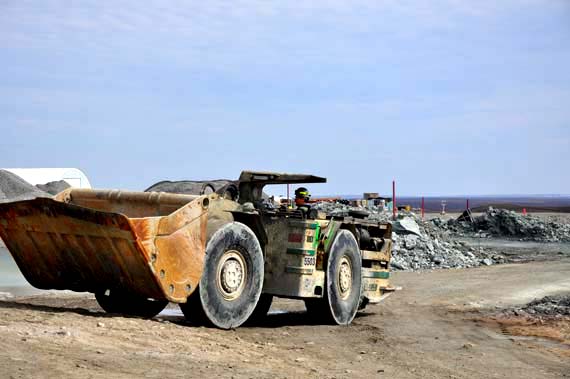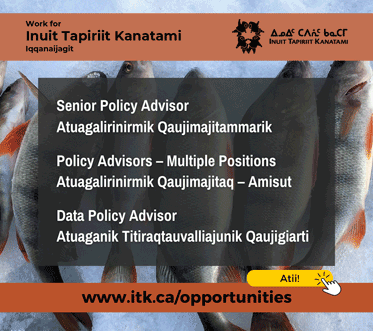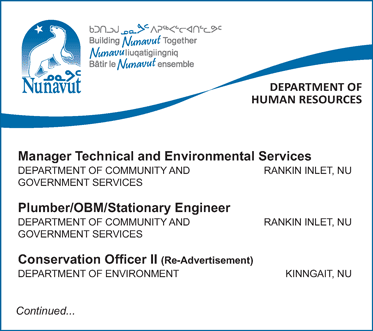Nunavut board gives green light to Meliadine gold mine
NIRB warns Ottawa that regulatory monitoring capacity is weak

Signage at the beginning of Agnico Eagle’s 24-kilometre road from Rankin Inlet to its Meliadine gold project site. In a second phase, this road will be widened to two lanes, with access to the public. Public trucks and cars, however, would be prohibited from using the upgraded road when large groups of caribou roam nearby and ATVs only would be allowed. (PHOTO BY SARAH ROGERS)

A scoop tram operates near Meliadine’s underground operation at its Tiriganiaq deposit. (PHOTO BY SARAH ROGERS)
The Nunavut Impact Review Board recommended Oct. 10 that the federal government approve Agnico Eagle’s proposed Meliadine gold mine, subject to 127 terms and conditions.
The review board, following a lengthy screening and environmental review process that started in 2011, has sent that recommendation to Bernard Valcourt, the minister of Aboriginal Affairs and Northern Development.
If Valcourt accepts the review board’s findings, Agnico Eagle will in the near future receive a project certificate for Meliadine containing all or most of the terms and conditions listed in the review board’s 342-page final hearing report. (See document embedded below.)
In that final hearing report, the review board said many participants at final public hearings held in Rankin Inlet this past August are “optimistic that the project will leave a positive legacy if developed correctly.”
But at the same time, the board members said they heard from people who are concerned the mine will create permanent and lasting changes to the landscape around the mine site and that its road and marine transportation systems could lead to adverse affects on caribou and marine mammals.
“The board heard that, in general, the residents of the Kivalliq communities welcome the employment opportunities that the Meliadine gold project represents, provided that it is developed in a responsible and sustainable manner,” the NIRB said.
And in a warning to Valcourt, the NIRB said also that many agencies and organizations with responsibilities for regulating the project suffer from big capacity problems, and may not have the staff or the money required to meet their mandates.
Located 24 kilometres north of Rankin Inlet, the Meliadine project would employ about 1,000 people during its construction phase and about 750 people after construction is completed.
Consisting of one underground mine, five open pits and a network of access roads, including an eventual two-lane all-weather road from Rankin Inlet to the mine site, Meliadine would receive ship-borne supplies at a place called Itivia, just to the south of the community.
A bypass road from Itivia would run around Rankin Inlet, so that heavy vehicles carrying mine materials will not have to travel through the community.
The current one-lane restricted all-weather road from Rankin Inlet to the mine site would be expanded to two lanes and Agnico Eagle would build a spur from that road creating public access to Meliadine Lake, with a parallel road, restricted to mine vehicles only, to the Discovery ore body.
Once the main all-weather road is widened to two lanes, it will open for public use.
But if groups of 50 caribou or more are spotted within one kilometre of the all-weather road, the road would be closed to public cars and trucks and only ATVS would be allowed.
And, after consultation with the Nunavut Wildlife Management Board, a no-shooting area would be created within one km of either side of the widened all-weather road.
At the same time, the NIRB recommends hunting and road use be monitored more closely when large herds of caribou migrate close to the road.
Agnico Eagle has not, however, yet announced a decision to construct a mine at Meliadine, which still operates as an advanced exploration site.
The company must also conclude an Inuit impact and benefit agreement with the Kivalliq Inuit Association.
In its report to Valcourt, the review board warned that many local and regional participants may not have the means to monitor the project over time.
That’s because all parties — such as federal and territorial government departments, Inuit associations, hunters and trappers organizations — may not be able to fulfill their monitoring responsibilities due to understaffing and lack of money.
They “all have experienced and expect to continue experiencing significant constraints on the financial, temporal and human resources required to fully and actively contribute to the NIRB process in the project review and monitoring stages,” the board said.
For example, the Canadian Coast Guard was unable to send a representative to the final public hearing this past August to answer questions about the Coast Guard’s emergency response capabilities.
The NIRB also said they have little guidance on how changes to federal laws like the Fisheries Act and the Navigation Protection Act affect regulations for fish habitat protection and the protection of water bodies from effluent.
“The board notes that a lack of regulatory capacity and full participation of authorizing agencies and landowners both during and after the board’s review is particularly troubling when, as is the case for this board review, there is uncertainty with respect to some effects predictions…,” the NIRB said.
“The board has serious concerns that limits on the ability of the affected communities and regulators to remain engaged in an ongoing basis with the project throughout its life-cycle will jeopardize the board’s ability to meet the promise of truly “setting the standard” for project development in Nunavut that is established by the Nunavut Land Claims Agreement and that is rightly expected by all Nunavummiut and all Canadians,” the board wrote.
To fix that, the NIRB made three non-binding recommendations of its own.
These include a capacity assessment that all parties would do within 12 months of the project certificate and within 24 months, and implementation plan to guide all agencies with a regulatory mandate for the project.
The NIRB also recommends that the Government of Nunavut provide information “in a clear format” to people in all Kivalliq communities, to inform them of education and training opportunities.





(0) Comments